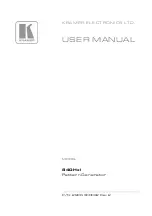
10
REV C
OPM-107
LOAD vs. OUTPUT
Generator
Load
Speed
(RPM)
Frequency
(Hz)
Voltage
120V
Recpt
240V
Recpt
None
3690
61.5
125V
258V
Half
3600
60.0
120V
240V
Full
3510
58.5
115V
230V
The speed of the engine was carefully adjusted at the factory so that
the generator produces the proper voltage and frequency. For normal
usage, the speed setting should not be changed. If the generator is
being run continuously on a very light load, it is often advisable to lower
the operating speed slightly.
The engine will govern itself at full speed. Intentionally overriding the
governor and operating the generator at low voltage may damage both
the generator and any load connected to it. Running the engine at
excessively high speeds results in high voltage, which may significantly
shorten the life of light bulbs and appliances being used, as well as
possibly damaging the engine.
CAUTION: EQUIPMENT DAMAGE
SPEED ADJUSTMENTS SHOULD ONLY BE MADE BY A QUALIFIED
SERVICE TECH. Whenever making any speed adjustments, check the
unit with a voltmeter and a frequency meter or a tachometer and be
sure the voltage and speed are correct.
Output voltage should be checked periodically to ensure continued
proper operation of the generating plant and appliances. If the
generator is not equipped with a voltmeter, it can be checked with a
portable meter.
CONNECTING THE LOADS
The engine-generator covered in this manual was designed for portable
use. Do NOT operate indoors. The unit should be stored in a warm, dry
location. Move the unit outdoors to a flat dry location for use.
APPLYING THE LOADS
Allow the engine to warm up for two or three minutes before applying
any load. This will allow the engine to reach normal operating
temperature and oil to circulate throughout the engine. A short warm-
up time will permit the engine to work more efficiently when the load
is applied and will reduce the wear in the engine, extending its life.
Receptacles have been provided to allow loads to be connected to the
generator.
The loads should be added one at a time. If a large motor is being
started: or multiple motors are being started, they should be started
individually and the largest should be started first.
CAUTION: EQUIPMENT OVERLOAD
Keep the generator load within in the generator and receptacle
nameplate rating. Overloading may cause damage to the generator
and/or the loads.
Most electric tools and appliances will have the voltage and amperage
requirements on their individual nameplates. When in doubt, consult
the manufacturer or a local electrician. The nameplate amperage rating
for electric motors can be misleading. See “Starting Electric Motors” in
the Unit Capabilities.
These engine-generator sets are inherently self regulating based on
engine speed. The engine governor will automatically adjust itself to the
load. No harm to the generator will result if it is operated with no load
connected.
CAUTION: EQUIPMENT DAMAGE
Diesel engines should never be run for an extended period of time with
a very light load or no load on them, it may do permanent damage to
the engine if run under these conditions.
Proper utilization of the receptacles located on the control panel
is necessary to prevent damage to either the receptacles or the
generator. The generator is a limited source of electrical power,
therefore, pay special attention to the receptacle and generator ratings.
The nameplate rating can be obtained through a single receptacle as
long as the receptacles amperage rating is not exceeded.
GROUNDING
All units must be grounded. Drive a 3/4 or 1” copper pipe or rod into
the ground close to the engine-generator set. The pipe must penetrate
moist earth. Connect an approved ground clamp to the pipe. Run a
no. 10 Awg wire from the clamp to the generator ground lug on the
receptacle panel. Do not connect to a water pipe or to a ground used
by a radio system. The engine-generators covered in this manual were
designed primarily for portable use. If you are connecting into a building


































